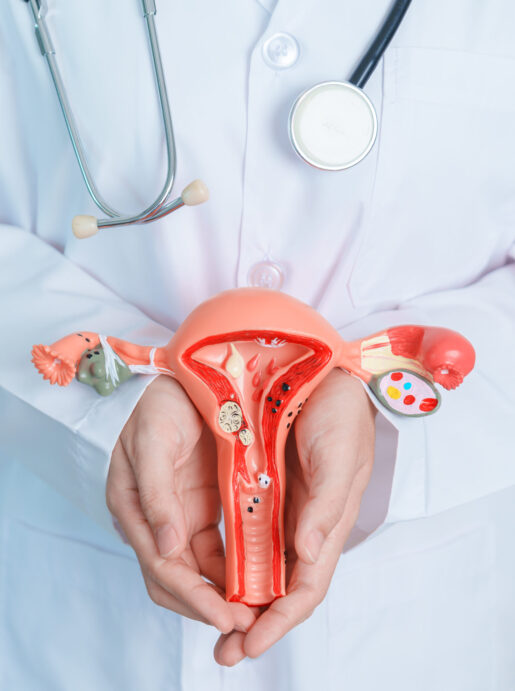Fibroid Management
Types and Management Options
Fibroids, also referred to as Myomas or Leiomyomas, are benign tumours that grow within the uterine muscle.
Though non-cancerous, fibroids can still significantly impact a woman’s health, depending on their number, size,
and location. Common symptoms include heavy menstrual bleeding, fertility issues, and pelvic pressure, all of which
can affect a woman’s quality of life and overall wellbeing.
Each woman’s experience with fibroids is unique, and our team is committed to working with patients to determine the best course of treatment.
If you're experiencing:
- Heavy bleeding
- Discomfort
- Fertility issues
We're here to guide you through every step of fibroid management, ensuring personalized care for your health and wellbeing.
Understanding the location of the fibroids is key to determining their impact.
Fibroids can be classified based on their position within the uterus.
Here is where they are
Submucous Fibroids
Submucous fibroids grow into the uterine cavity and are often linked to symptoms such as heavy bleeding and fertility challenges. Their location can interfere with the normal function of the uterine lining, making it harder for some women to conceive or maintain a pregnancy.
For women with submucous fibroids, a hysteroscopic resection is typically very effective in reducing menstrual bleeding and improving fertility.
Intramural Fibroids
Found within the muscular wall of the uterus, these fibroids can cause a range of symptoms, including heavy periods, pelvic pain, and a feeling of fullness in the lower abdomen. They can also contribute to fertility challenges, depending on their size and how they affect the uterine structure.
Subserous Fibroids
These grow on the outer surface of the uterus and are less likely to cause heavy bleeding. However, they can press on surrounding organs, causing symptoms such as pelvic pressure, bloating, or frequent urination, especially when they become larger.
Pedunculated Fibroids
Attached to the uterus by a stalk, pedunculated fibroids can grow either inside or outside the uterus. They may cause pain or discomfort if they twist, cutting off their own blood supply.
Fibroid management at NG GyneHealth is tailored to the unique needs of each patient. Our team offers a range of treatment options depending on the severity of symptoms, the size of the fibroids, and a woman’s reproductive plans. These options include:

Option One
Medication
Hormonal treatments can be used to help regulate menstrual bleeding and alleviate symptoms. Medications such as GnRH agonists can shrink fibroids temporarily, often used in preparation for surgery.
Option Two
Non-surgical Treatments
For some women, procedures such as uterine artery embolisation can be effective in shrinking fibroids by cutting off their blood supply. This minimally invasive technique is ideal for women seeking to preserve their uterus and avoid more invasive surgery.
Option Three
Surgical Management
For larger or more problematic fibroids, surgical removal may be recommended. Myomectomy is a procedure that removes fibroids while leaving the uterus intact, making it an option for women wishing to preserve fertility. For women with severe symptoms or who no longer plan to have children, a hysterectomy may be suggested. When possible, we perform this surgery laparoscopically, allowing for faster recovery and minimal scarring.
Option Four
Hysteroscopic Treatment of Fibroids
In women with Submucous fibroids, Hysteroscopic resection of the fibroid is generally very rewarding in reducing menstrual loss and restoring fertility. The surgery is done without any cuts on the belly as a day only procedure and needs hardly any time for recovery. The data on surgical resection of intramural and Subserous fibroids to address these concerns remains less conclusive.

N.G. GyneHealth Care Pty. Ltd. © 2006-2025. ABN: 68 119 441 413
Web design by Beetle Digital Pty. Ltd.







